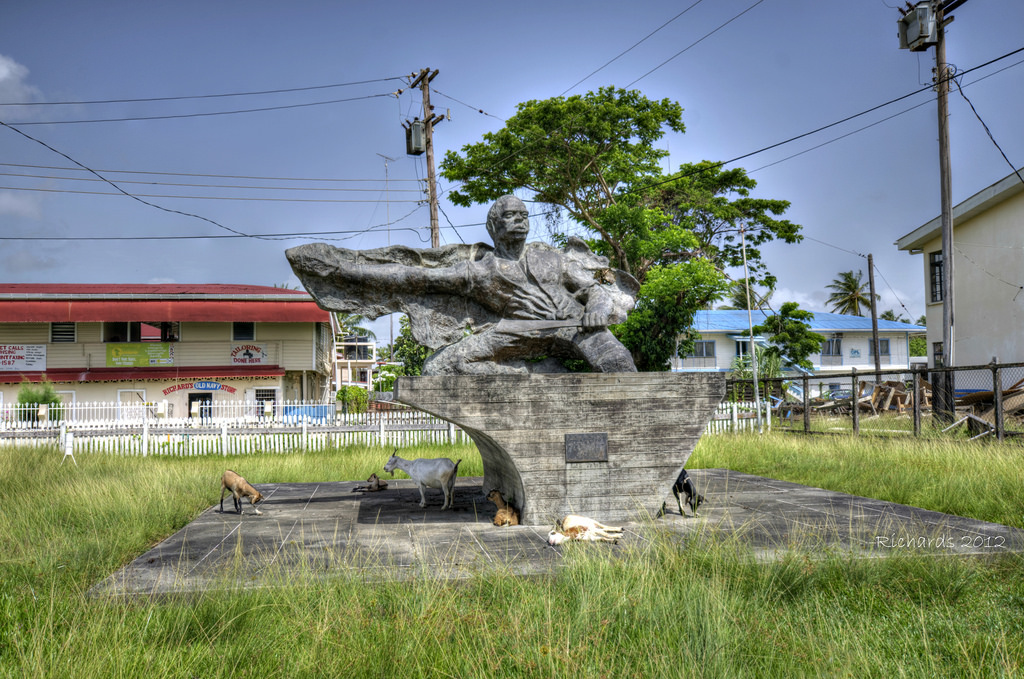The Damon monument located at the Anna Regina car park is a site to see whenever visiting the Essequibo Coast. Damon was tried and sentenced to death for inciting plantation labourers to strike.
Upon protesting against a new system of Apprenticeship, the heroic African domestic labourer Damon was executed. As a result of this tragedy, a monument was created on behalf of him. The erection of the monument to honour the fallen hero, Damon, was proposed by the Guyana Commemoration Commission in 1985. Mr. Ivor Thom, a lieutenant of the Guyana National Service, was selected to sculpt the monument which was erected on July 31, 1988.
Origin
On August 3, 1834 labourers went on strike declaring that they were free and would only work for half a day.
This was done in the Trinity Church Yard at La Belle Alliance whereby over one hundred ex slaves were gathered. During that period there were sporadic stoppages of work throughout the week starting Sunday, August 3,1834. Planters eventually called for troops and armed soldiers who took up their position around the churchyard. Their leader Damon during that time decided to raise a flag to represent the labourers who were peacefully protesting. The minister appealed to the crowd to disperse but they refused since they considered themselves free and unwilling to return to the plantations to be forced to work. They believed they were taking refuge in the churchyard which belonged to the King. Further, Charles Bean, proprietor of plantation richmond tried to address the workers but he too also failed to convince them to disperse. He only added to their anger by his threats and display of arrogance. He then ordered his soldiers to arrest two of the ringleaders but the two were immediately rescued by their friends.
Bean wanted the soldiers to open fire but they insisted on getting approval first, from the governor since the crowd were free people and not a mob. The governor arrived a few days after taking down Damon’s flag which flew proudly.
Charles Bean, wanted his apprentices to remain bound to estate labor. And so, he joined with other planters to kill sixty-five pigs of which belonged to his workers. This was justified by the planters because it was said that the pigs destroyed the roots of the young canes. As such, they believe that, in which the real reason was to cut off any alternative livelihood.
Damon and a number of others were taken to Georgetown, tried and found guilty of rebellion. None of these men had threatened a single planter or his property and had not attacked anyone. They had simply stopped working for a few days and assembled under their own flag. Damon was sentenced to be hanged.
Few months after Damon was hanged on a scaffold at the Parliament Building at noon on Monday, 13 October 1834. He was executed for demanding justice for his African brethren in the “Apprenticeship system”, after slavery was abolished. Damon was indeed an idol and will be remembered for his quest for freedom.
Features
This monument of Damon in a giant chair is sculpted of bronze by Claude Geddes, the Managing Director of Brass Aluminium and Cast Iron Foundry Limited. It weighs three tons and stands nine feet tall resting on a concrete plinth.
Six clay models were cast before one entitled ‘Maquette’ was chosen as the design of the sculpture.
The monument wouldn’t have been a success if it wasn’t financed through government funding, as well as public contributions. Upon completion, and prior to the official ceremony of dedication in Essequibo, the monument was displayed in front of the Parliament Buildings allowing the residents of the city an opportunity to view the sculpture.
The sculpture was unveiled at Anna Regina on the Essequibo Coast on the 150th anniversary of Emancipation celebrations on July 31, 1988 at Damon Park. Many of the officials of the State who were in attendance remarked at the beauty of the new monument.
Damon’s Cross
This simple concrete cross is believed to mark the spot where Damon, the enslaved African was buried after being executed for his role in the 1823 Demerara uprising. Damon’s Cross is located in the La Belle Alliance cemetery on the Essequibo Coast.
Associates
There were actually four(4) of Damon’s compatriots Fothergill, Frederick, Bob, William who were sentenced to be transported to New South Wales. While awaiting the time to be shipped, they were held in the prison ships (Hulks) in London, England.
Bob died primarily from the rigors of the 1834 winter. Fothergill, Frederick and William were pardonned and sent back to Demerara arriving on October 13, 1835.
Article References
- https://guyaneseonline.net/2011/10/13/damon-%E2%80%93-freedom-fighter-hanged-october-13-1834/
- http://nationaltrust.gov.gy/regional-monuments/region-2/
- http://www.landofsixpeoples.com/news022/nc2110310.htm
- http://wwwvisitsitescom.blogspot.com/
- http://guyanainc.biz/tourism-and-culture/african-monuments-and-museums-in-guyana/







